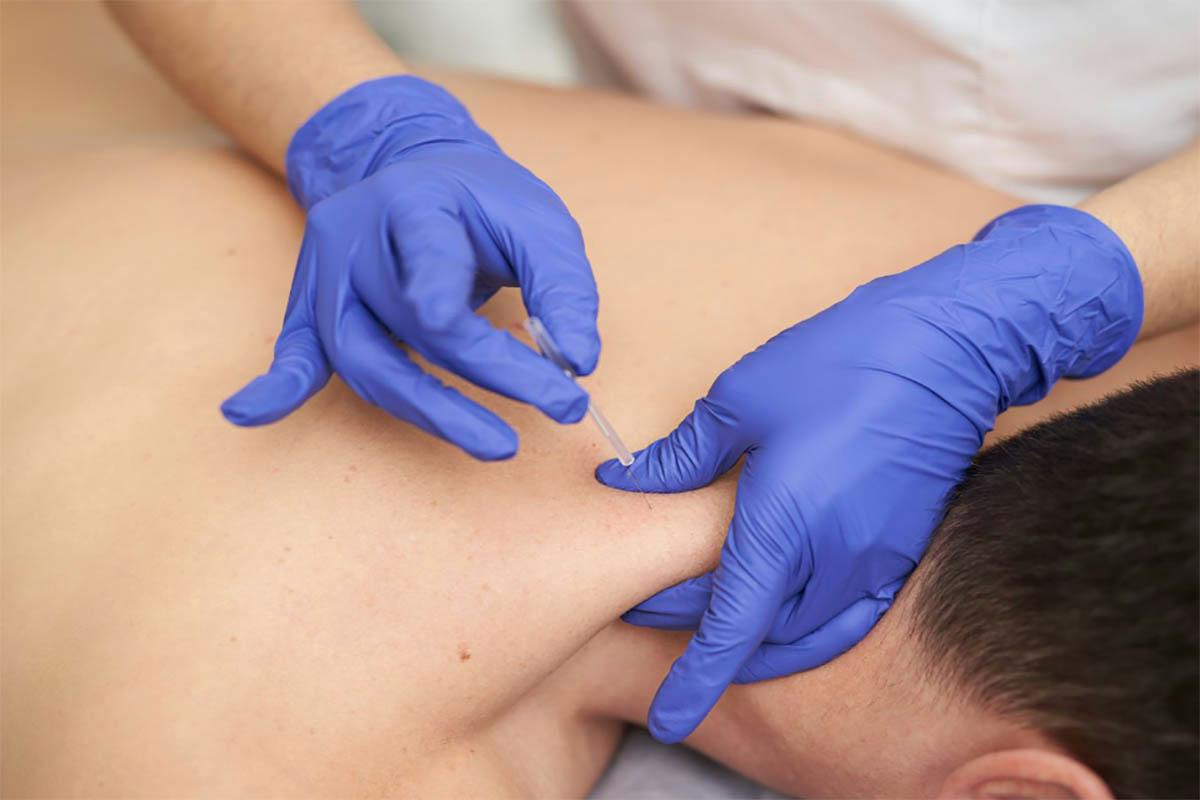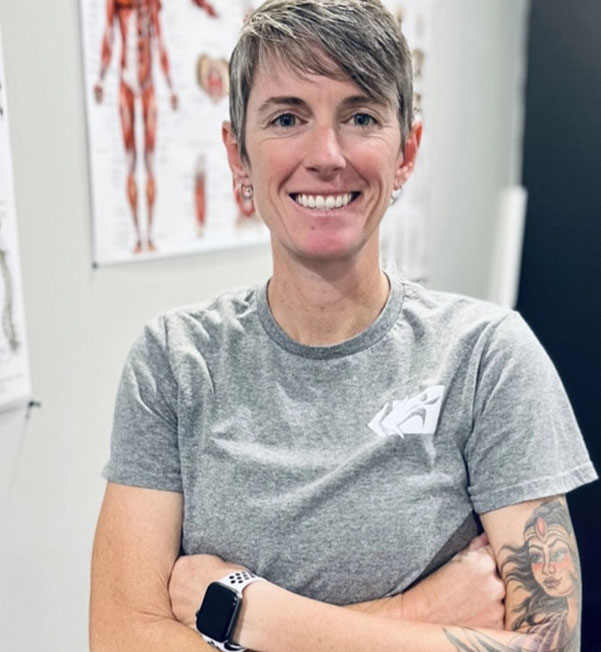Introduction
Dry needling, a therapeutic technique gaining popularity and contributing to accelerated recovery, prompts the question: Does dry needling hurt? Let’s explore this intriguing topic and unravel the mysteries behind this practice to understand why it’s becoming a sought-after and effective treatment. Although often compared to acupuncture, this technique distinguishes itself through its unique methodology and primary objectives, aligning more closely with Western medicine practices.
What is Dry Needling
Dry needling involves inserting thin needles into specific muscle trigger points to release tension, alleviate chronic pain, and promote natural healing mechanisms, including improving blood flow and releasing endorphins.
This therapeutic intervention also targets the stimulation of connective tissues to enhance overall musculoskeletal health. Often compared to acupuncture, dry needling stands out with its unique approach, offering a multifaceted solution for various musculoskeletal issues.
How Does Dry Needling Work?
Dry needling operates on a simple yet effective methodology. Using filiform needles to stimulate a trigger point encourages the return of normal blood supply, flushing out the area and relieving tension. The sensation from the prick can activate nerve fibers, prompting your brain to release endorphins, which act as your body’s natural pain relief.
This straightforward yet precise process, forming the core methodology behind the success of dry needling as a therapeutic intervention, is often administered by a skilled and experienced physical therapist.
What are the benefits of dry needling?

Advocates of dry needling emphasize a range of benefits that make it a sought-after therapy for addressing various musculoskeletal conditions, with a detailed breakdown of the advantages of trigger point dry needling.
Pain Relief
Dry needling is renowned for its effectiveness in providing relief from musculoskeletal pain. The precise targeting of trigger points helps alleviate muscle tension and tightness discomfort. Dry needling is used to reduce the pain caused by MTrPs as part of rehabilitation.
Improved Flexibility
By releasing tension in specific muscles, dry needling techniques enhance flexibility and range of motion. This is particularly advantageous for individuals facing stiffness or restricted mobility.
Reduced Muscle Tension
The primary objective of dry needling is to address myofascial trigger points, which are often responsible for muscle tension. The procedure helps release this tension, promoting a more relaxed and comfortable state in the treated muscles.
Certain patients experience a 50% reduction in pain after a single session, while others achieve relief through multiple sessions.
Is dry needling painful?
Addressing the elephant in the room: does it hurt? The subjective nature of pain perception plays a significant role. While some may feel minimal discomfort, others may report no pain at all. Understanding individual pain thresholds is crucial, ensuring a comfortable journey towards recovery.
Factors that Affect Pain During Dry Needling
Various factors influence the level of discomfort during dry needling, each playing a crucial role in shaping the overall experience and contributing to the recovery process. Here’s a detailed list:
Patient’s Pain Tolerance
- Individuals vary in their sensitivity to pain. A patient’s pain tolerance significantly impacts how they perceive the sensations during dry needling.
- Higher pain tolerance may result in minimal discomfort, while lower tolerance could lead to a more intense sensation.
Practitioner’s Skill and Experience
- The proficiency of the practitioner performing dry needling is a critical factor. A skilled and experienced practitioner will likely insert needles more accurately, minimizing potential discomfort.
- Skillful practitioners can tailor the treatment to the individual, ensuring a precise and effective session.
Specific Muscle Being Treated
- The location and characteristics of the muscle being treated also influence the pain level during dry needling.
- Muscles with denser fiber arrangements or those closer to sensitive areas may result in varying degrees of discomfort.
What to Expect After Dry Needling
After a dry needling session, individuals may encounter immediate effects, the majority of which are short-lived and contribute to the overall effectiveness of the treatment.
Here’s what you can expect:
Soreness is a normal response to manipulating muscle fibers and typically fades quickly. Soreness is often comparable to that experienced after an intense workout and indicates the therapeutic process, particularly targeting taut bands.
- Short-Lived Effects: Discomfort tends to dissipate within a short timeframe after the session concludes. The short duration of these effects underscores the non-invasive and efficient nature of dry needling, particularly in targeting specific muscle tissue for therapeutic benefits.
- Understanding Potential Side Effects: Though uncommon, there may be potential side effects such as bruising or minor bleeding at the needling sites during dry needling. These side effects are typically minimal and temporary, ensuring the procedure’s safety, particularly in addressing specific conditions like myofascial pain.
- Preparing for a Smoother Post-Treatment Recovery Experience: Hydration, gentle stretching, and following any post-treatment guidelines provided by the practitioner can aid in minimizing discomfort and optimizing the benefits of the session, promoting the smooth flow of energy throughout the treated areas.
Who shouldn’t get dry needling treatments?

While dry needling is generally beneficial, it may not be suitable for everyone. Take into account these five groups of individuals who should consult with a healthcare professional before contemplating this therapy:
Pregnant Individuals
- Individuals who are pregnant, especially in the first trimester, should use caution and consult with their healthcare provider before choosing to undergo dry needling.
Individuals with Blood Clotting Disorders
- Those with blood clotting disorders or taking blood-thinning medications should seek careful evaluation before undergoing dry needling due to an increased risk of bleeding or bruising.
People with a Fear of Needles
- Individuals with a significant fear of needles may find dry needling distressing, potentially impacting the effectiveness of the treatment. Alternative therapies may be explored in such cases. Additionally, those with allergies to metals in Chinese medicine may need to explore alternative options or materials.
People with Skin Infections
- Active skin infections in the areas where needling is intended may pose a risk of spreading the infection. Dry needling should be avoided until the infection is fully resolved.
Patients with a History of Fainting or Vasovagal Syncope
- Those with a history of fainting or vasovagal syncope may be at risk of fainting during or after dry needling. Precautions should be taken to ensure a safe environment.
Conclusion
In conclusion, dry needling emerges as a promising therapeutic approach, relieving many. The question of whether it hurts is subjective, with individual experiences varying. The crucial aspect is comprehending the procedure and maintaining open communication with the practitioner, fostering a personalized path to recovery.
If you’re intrigued by the potential benefits of dry needling, consider reaching out to Progressive Mobility Physio & Performance to explore how this technique could contribute to your well-being. Take a step towards a pain-free and more mobile future—connect with us today!
FAQs
Q1: What Does Dry Needling Feel Like?
A1: Sensations during dry needling differ among individuals. Some report a mild tingling, while others feel no sensation at all. Open communication with your practitioner ensures a personalized and comfortable experience, supporting your unique path to recovery.
Q2: How effective is dry needling for migraines?
A2: Dry needling holds promise as a therapeutic solution for migraine management, with reported reductions in frequency and intensity. The technique targets muscle tension, promoting relaxation for migraine relief. Yet, it is vital to consult with a healthcare professional to evaluate individual conditions and determine the most suitable approach for effective migraine management.
Q3: How Long Does Dry Needling Last?
A3: The duration of dry needling effects varies. While some experience immediate relief, others may need multiple sessions for sustained benefits. Consult with your practitioner to determine the optimal treatment plan for a timely recovery.


